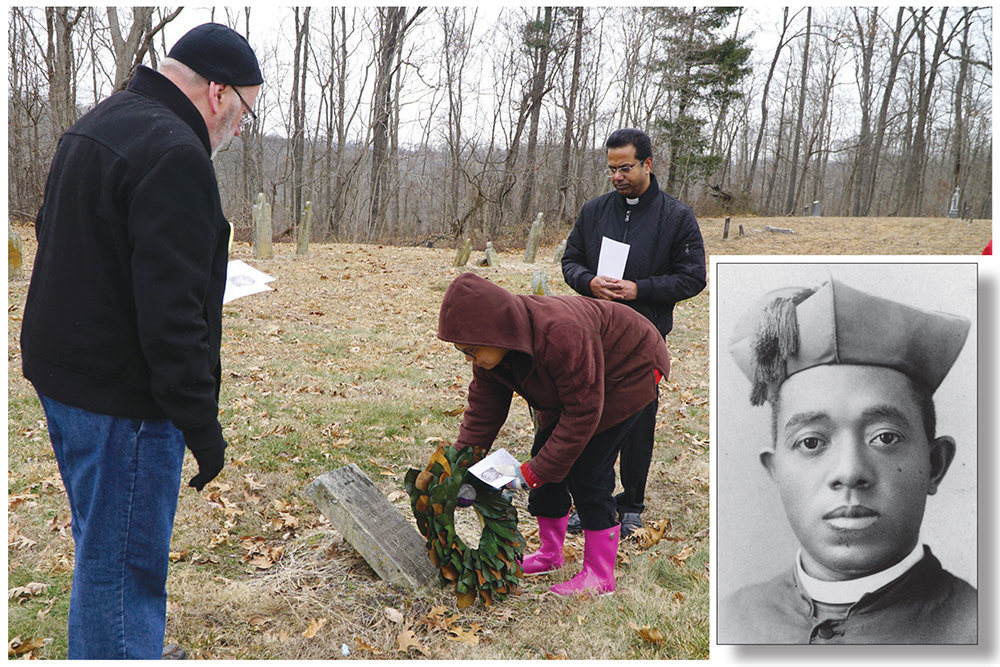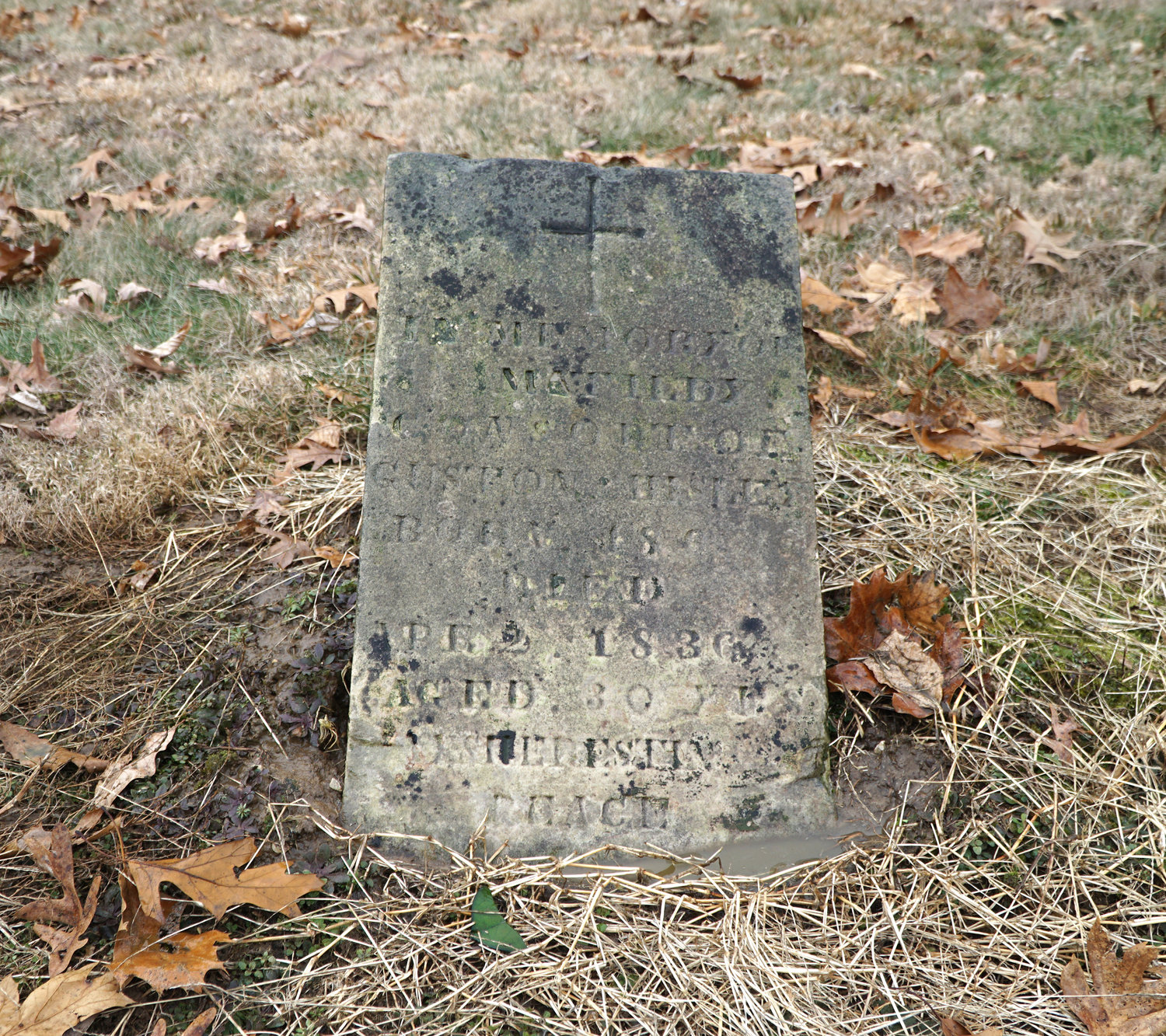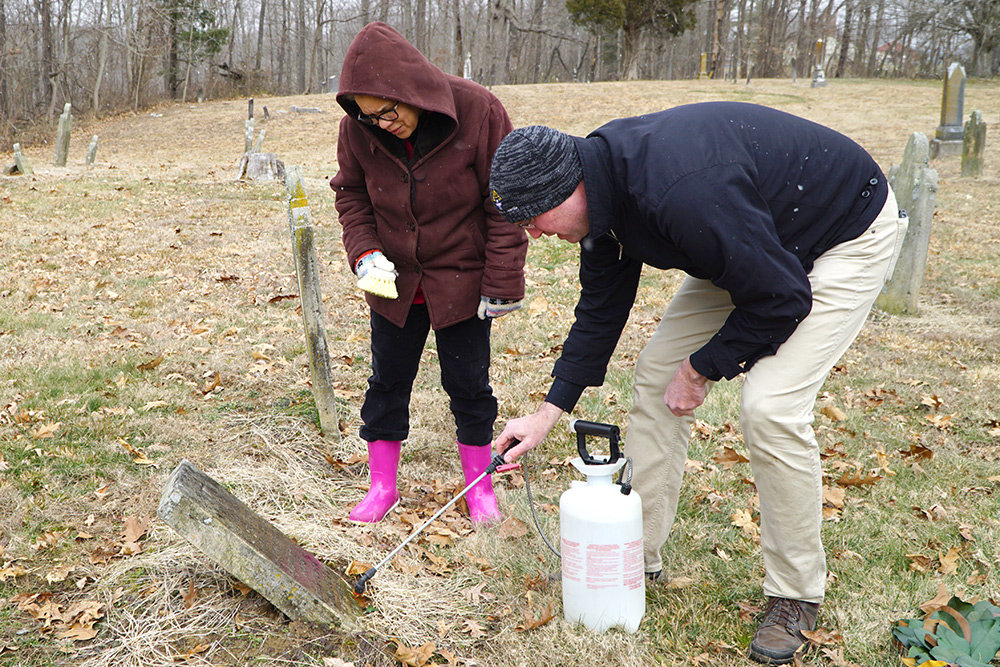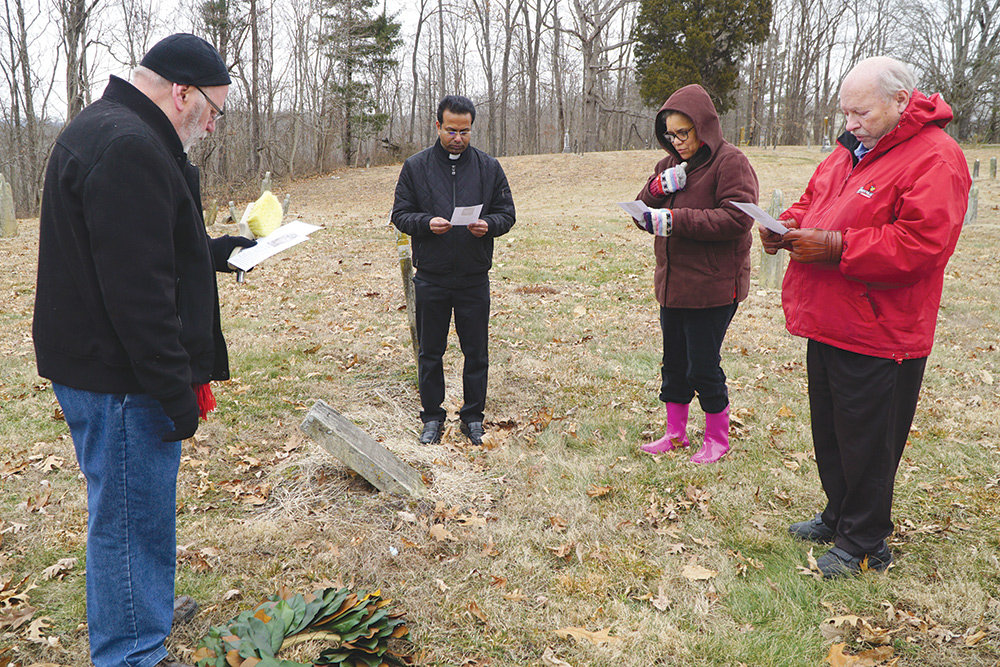Venerable Fr. Tolton’s grandmother is at rest in an old Catholic cemetery in Kentucky

I confess to almighty God
and to you,
my brothers and sisters,
that I have greatly sinned,
in my thoughts and in my words,
in what I have done and in what I have failed to do,
(Striking breast) through my fault, through my fault,
through my most grievous fault;
therefore I ask blessed Mary ever-Virgin,
all the Angels and Saints,
and you, my brothers and sisters,
to pray for me to the Lord our God.
On a wintry January day at the old St. Theresa Cemetery in rural Meade County, Janice Mulligan laid a simple wreath of magnolia leaves on the grave of Matilda (Hurd) Chisley — a woman who spent her life in slavery and whose grandson is now a saint in the making.
Matilda, who died in 1836 at age 30, was enslaved on a farm belonging to John Henry Manning.
She was also the maternal grandmother of Venerable Augustus Tolton — the Church’s first recognizably Black priest in the United States.
Baptized in Brush Creek in what is now part of the Jefferson City diocese, Fr. Tolton was ordained in Rome in 1886, died in 1897 in Chicago and is on under formal consideration for being declared a saint.
Pope Francis affirmed in June 2019 that Fr. Tolton lived a life of heroic virtue, giving him the title of Venerable.
The next step in the process, known as beatification, would require a miracle attributed to God through Fr. Tolton’s intercession in heaven.
Ms. Mulligan, who serves as the associate director of the Archdiocese of Louisville’s Office of Multicultural Ministry, said that while standing over Matilda’s grave, “her story felt like a part of my family’s story.”
On that January day, Father J. Ronald Knott, a retired priest of the Archdiocese of Louisville, led a small group, including Ms. Mulligan, in reciting the “Confiteor” before the wreath laying.
That penitential prayer seemed fitting for the moment, especially the words, “in what I have done and in what I have failed to do,” said Fr. Knott, who grew up in Rhodelia and attended St. Theresa Church as a child.
From age to age
Fr. Knott said he recently became aware that Matilda’s earthy remains are buried in the old St. Theresa Cemetery in Rhodelia. He is leading a project to convert the old St. Theresa School building into a community center.
He said he plans to use one of the center’s hallways as a museum where historic photographs and documents from the parish community will be displayed.
In searching for old photos and researching the history of the more than 200-year-old parish, Fr. Knott said, “All of a sudden it became clear to me that part of our history” is rooted in slavery.
“I was shocked by it,” he said. “I didn’t know there were slaves in the parish.”
His research shows there were about 50 families at St. Theresa who collectively enslaved about 200 people.
Fr. Knott is studying St. Theresa’s baptismal records to find the names of enslaved people baptized at the parish.
“We need to say their names — Matilda, Maria, Augustus, Sicilia,” he said. “We didn’t even know their names and it’s right there in the baptismal records and in the cemetery.”
His research eventually turned up the baptismal records of Matilda’s children — Charles, Anne, Sicilia, Sicilia Ellen and Martha Jane.
Martha Jane is the mother of Fr. Tolton.
“The more I studied, I realized this family was related to Fr. Tolton,” said Fr. Knott.
Their names and the names of the other enslaved people will be displayed on the history wall in the Family Life Center because they were parishioners at St. Theresa, too, he said.
“As people walk down the hall seeing the names of the priests and the (religious) sisters, they’ll see the names of the slaves who made some families here successful,” he said.
“As far as little parishes in the country, St. Theresa was more advanced and well-to-do,” he noted, and it was because of slave labor.
Fr. Knott said the parish is still benefiting from the labor of enslaved people who, he believes, quarried the rocks used for the foundation and made the bricks from which the current St. Theresa Church was built.
The church was dedicated in 1861 by Bishop Martin John Spalding.
Called by name
Fr. Knott noted he’s not interested in “shaming” anyone. Instead, he wants to celebrate the contribution of enslaved people to his boyhood parish, learn and pass on the parish’s whole history — “not only white history” or a “sanitized version” of that history — to the younger generation.
If they will stand against “prejudice and bigotry,” they need to be aware of the parish’s history with slavery, said Fr. Knott.
Ms. Mulligan agrees that the contributions of enslaved people to the parishes in the Louisville archdiocese should be recognized.
“Having her (Matilda’s) name recognized, especially in the context of her grandson becoming one of the first African American saints in the U.S. ...there’s a legacy and story there, rich and worth telling,” she said. “The work of this office is to promote and spread that African American legacy, whether in the 1800s or now.
“Her story and others like it adds a fuller thread and a fuller context to the presence and contributions of African Americans to this American church,” she said. “It certainly can be better promoted and appreciated.”
What God has joined
Part of Matilda’s story takes place on the farm in Rhodelia owned by John Henry Manning and his wife Ann Gough, who were members of St. Theresa Parish.
Matilda was married to Augustus Chisley, another enslaved person on the Manning farm, said Dr. Emilie Leumas, an archivist who serves on the historical commission for Fr. Tolton’s sainthood cause.
Augustus and Matilda had six children.
In 1835, when Mr. Manning died, he bequeathed all his belongings — about 1,200 acres of land, personal items such as silver, his watch, his Bible and his 17 enslaved people — to his children and grandchildren whose parents had died, said Dr. Leumas.
Details from Manning’s will show that Matilda and Augustus and their children were separated. Their oldest children, Martha Jane, 11, and Charles, 6, were left to Mr. Manning’s granddaughter Anne Sevilla Manning.
Dr. Leumas noted that by the time the will was read, Anne Sevilla Manning and her family had moved to Ralls County, Missouri.
At some point following the reading of the will, Charles and Martha Jane — the mother of Fr. Tolton — were moved to Missouri to live with their new owner.
“How gut-wrenching that your two oldest children are being hauled away to Missouri!” said Dr. Leumas during a recent interview.
When Anne Sevilla Manning married Stephen Elliott in 1839, she would have brought Charles and Martha Jane into her marriage as part of her dowry, Dr. Leumas said.
More than a decade later, Martha Jane, now the mother of three young children, including young Augustus, 7 years old at the time, escaped slavery and fled to Quincy, Illinois, where the future Fr. Tolton grew up and was formed in the Catholic faith.
Dr. Leumas said she’s not found documents clarifying whether Matilda and Augustus and their children were immediately separated after the will reading.
Her “gut instinct” is they were allowed to live together and walk to work on the farm of their new owner, noting that Matilda would have had a 2-year-old and also would have been nursing an infant at the time.
“Working people and your land was a business, and they were looking at it that way,” said Dr. Leumas. “The Manning heirs would have still worked the land the way their father did. It’s just the ownership that changed.”
Free at last
Matilda died in 1836, a year after Mr. Manning’s will was read. She is buried a few feet away from a large wooden cross that marks where the old church, a log structure, once stood.
St. Theresa Parish started out in a log cabin on the banks of the Ohio River, an area that was known as Flint Island in 1818. A second log cabin was built in 1826 on what is now the old cemetery grounds.
Fr. Knott noted that Matilda is buried among St. Theresa’s white parishioners, perhaps because she was baptized.
A cemetery located in a wooded area off a highway about two miles from the former church site was used to bury enslaved people owned by St. Theresa parishioners, as well. Those slaves, he said, may not have been baptized. He is leading a project to find all the headstones in that cemetery.
Annette Mandley-Turner, who serves as executive director of the Archdiocese of Louisville’s Office of Multicultural Ministry, said knowing that enslaved people were given Christian burial is an important part of the history of slavery and Black Catholics.
“Burial is such a human thing to do when the treatment of us was so different,” she said in a recent interview. “It’s one of the things I can say the Catholic Church did right. They made sure they buried them. It sends the message they didn’t bury people in isolation. There was someone there to witness the homegoings.”
A time to heal
Ms. Mandley-Turner said she hopes Fr. Knott will have success in “displaying what I would perceive to believe is a history that includes everyone...Maybe this will energize some other rural communities to look in their graveyards.”
Ms. Mulligan agrees that uncovering this history is important and that recognizing enslaved people is part of a healing process.
“Telling this story and the type of actions that Fr. Knott is planning in terms of making sure those names are known, is part of the healing process that needs to happen with this history,” Ms. Mulligan stated.
“I think that is a form of reparation. I see it as a process very much in alignment with the Catholic process of reconciliation, where there’s an acknowledgment of a wrong or damage to a relationship and then there’s the work to repair it,” she said.
Ruby Thomas is a staff writer for The Record, newspaper of the Archdiocese of Louisville, Kentucky.
Comments
Other items that may interest you
Services
The Catholic
Missourian
2207 W. Main St.
Jefferson City MO 65109-0914
(573) 635-9127
editor@diojeffcity.org









